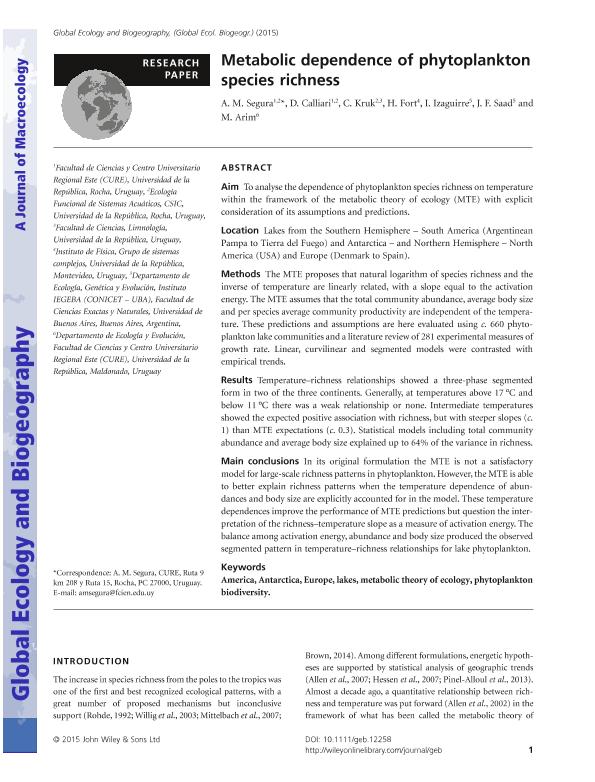Mostrar el registro sencillo del ítem
dc.contributor.author
Segura, A. M.
dc.contributor.author
Calliari, Danilo Luis

dc.contributor.author
Kruk, C.
dc.contributor.author
Fort, H.
dc.contributor.author
Izaguirre, Irina

dc.contributor.author
Saad, Juan Francisco

dc.contributor.author
Arim, M.
dc.date.available
2018-04-26T12:50:07Z
dc.date.issued
2015-01
dc.identifier.citation
Segura, A. M.; Calliari, Danilo Luis; Kruk, C.; Fort, H.; Izaguirre, Irina; et al.; Metabolic dependence of phytoplankton species richness; Wiley Blackwell Publishing, Inc; Global Ecology and Biogeography; 24; 4; 1-2015; 472-482
dc.identifier.issn
1466-822X
dc.identifier.uri
http://hdl.handle.net/11336/43507
dc.description.abstract
Aim To analyse the dependence of phytoplankton species richness on temperature within the framework of the metabolic theory of ecology (MTE) with explicit consideration of its assumptions and predictions. Location Lakes from the Southern Hemisphere – South America (Argentinean Pampa to Tierra del Fuego) and Antarctica – and Northern Hemisphere – North America (USA) and Europe (Denmark to Spain). Methods The MTE proposes that natural logarithm of species richness and the inverse of temperature are linearly related, with a slope equal to the activation energy. The MTE assumes that the total community abundance, average body size and per species average community productivity are independent of the temperature. These predictions and assumptions are here evaluated using c. 660 phytoplankton lake communities and a literature review of 281 experimental measures of growth rate. Linear, curvilinear and segmented models were contrasted with empirical trends. Results Temperature–richness relationships showed a three‐phase segmented form in two of the three continents. Generally, at temperatures above 17 °C and below 11 °C there was a weak relationship or none. Intermediate temperatures showed the expected positive association with richness, but with steeper slopes (c. 1) than MTE expectations (c. 0.3). Statistical models including total community abundance and average body size explained up to 64% of the variance in richness. Main conclusions In its original formulation the MTE is not a satisfactory model for large‐scale richness patterns in phytoplankton. However, the MTE is able to better explain richness patterns when the temperature dependence of abundances and body size are explicitly accounted for in the model. These temperature dependences improve the performance of MTE predictions but question the interpretation of the richness–temperature slope as a measure of activation energy. The balance among activation energy, abundance and body size produced the observed segmented pattern in temperature–richness relationships for lake phytoplankton.
dc.format
application/pdf
dc.language.iso
eng
dc.publisher
Wiley Blackwell Publishing, Inc

dc.rights
info:eu-repo/semantics/openAccess
dc.rights.uri
https://creativecommons.org/licenses/by-nc-sa/2.5/ar/
dc.subject
America
dc.subject
Antarctica
dc.subject
Europe
dc.subject
Lakes
dc.subject
Metabolic Theory of Ecology
dc.subject
Phytoplankton Diversity
dc.subject.classification
Otras Ciencias Biológicas

dc.subject.classification
Ciencias Biológicas

dc.subject.classification
CIENCIAS NATURALES Y EXACTAS

dc.title
Metabolic dependence of phytoplankton species richness
dc.type
info:eu-repo/semantics/article
dc.type
info:ar-repo/semantics/artículo
dc.type
info:eu-repo/semantics/publishedVersion
dc.date.updated
2018-04-10T20:10:42Z
dc.identifier.eissn
1466-8238
dc.journal.volume
24
dc.journal.number
4
dc.journal.pagination
472-482
dc.journal.pais
Reino Unido

dc.journal.ciudad
Londres
dc.description.fil
Fil: Segura, A. M.. Universidad de la República; Uruguay
dc.description.fil
Fil: Calliari, Danilo Luis. Universidad de la República; Uruguay
dc.description.fil
Fil: Kruk, C.. Universidad de la República; Uruguay
dc.description.fil
Fil: Fort, H.. Universidad de la República; Uruguay
dc.description.fil
Fil: Izaguirre, Irina. Consejo Nacional de Investigaciones Científicas y Técnicas. Oficina de Coordinación Administrativa Ciudad Universitaria. Instituto de Ecología, Genética y Evolución de Buenos Aires. Universidad de Buenos Aires. Facultad de Ciencias Exactas y Naturales. Instituto de Ecología, Genética y Evolución de Buenos Aires; Argentina
dc.description.fil
Fil: Saad, Juan Francisco. Consejo Nacional de Investigaciones Científicas y Técnicas. Oficina de Coordinación Administrativa Ciudad Universitaria. Instituto de Ecología, Genética y Evolución de Buenos Aires. Universidad de Buenos Aires. Facultad de Ciencias Exactas y Naturales. Instituto de Ecología, Genética y Evolución de Buenos Aires; Argentina
dc.description.fil
Fil: Arim, M.. Universidad de la República; Uruguay
dc.journal.title
Global Ecology and Biogeography

dc.relation.alternativeid
info:eu-repo/semantics/altIdentifier/doi/http://dx.doi.org/10.1111/geb.12258
dc.relation.alternativeid
info:eu-repo/semantics/altIdentifier/url/https://onlinelibrary.wiley.com/doi/abs/10.1111/geb.12258
Archivos asociados
